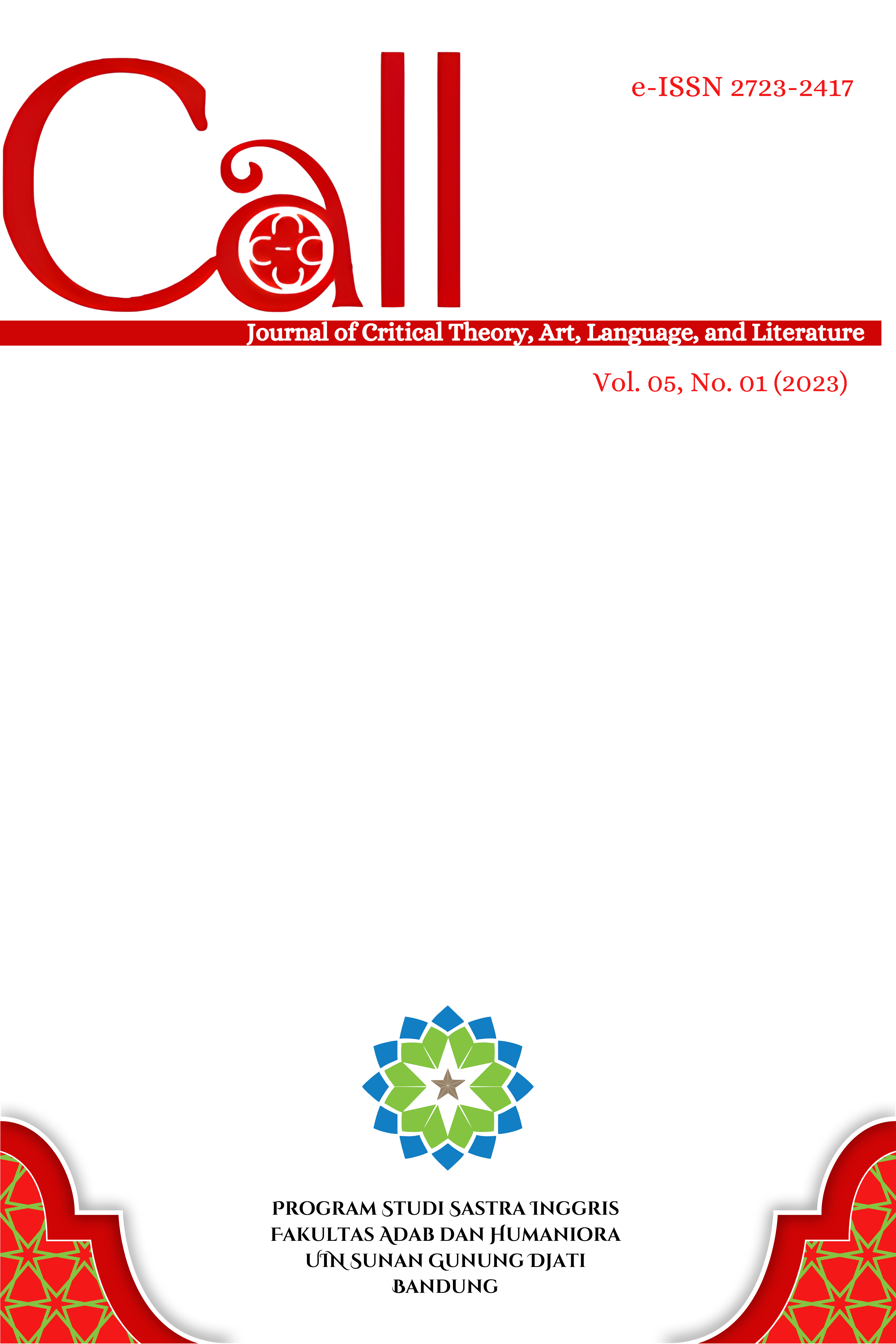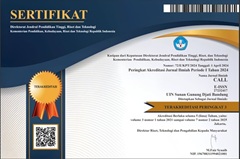MENTAL ILLNESS OF BRUCE WAYNE IN BATMAN BEGINS (2005) AND TONY STARK IN IRON MAN (2010)
DOI:
https://doi.org/10.15575/call.v5i1.14914Abstract
Literary psychology is defined as a field of study that examines literary works that involve fictional or factual characters acting out events from human life. Superheroes figure started to show up in 1930s, their characters were always written as a perfect human being due to the WW II. This study compared mental illnesses encountered by the two major protagonists in Christopher Nolan's Batman Begins (2005) and Jon Favreau's Iron Man 2 (2010) films. Mental issues have been very openly discussed in the current days and there are lots of movies which started to portray mental issues in the story, including superhero movies. This was a comparative literature from Bassnett (1993) and Damono (2009) to discover the similarities and differences between the characters, as well as Psychology of Literature by Minderop (2010) assisted by structuralism theory and theories of mental disorder from psychology. This study used a qualitative method. The results showed that Batman and Iron Man suffer from several mental illnesses, such as: depression, anxiety, antisocial, schizoid, PTSD, narcissistic, histrionic, and OCD. The study concluded that both main characters as the centre of the story who have an internal problem within themselves because of their mental illnesses.
Â
Keywords: comparative literature, psychology of literature, mental illness, main characterReferences
Association, A. P. (2013). Diagnostic and statistical manual of mental disorders (5th ed.). Washington, DC: APA.
Association, A. P. (2013). Major depressive disorder and the “bereavement exclusionâ€. Washington DC: APA.
Association., A. P. (1994). Diagnostic and statistical manual of mental disorders.
Bassnett, S. (1993). Comparative: a critical introduction. Oxford: Blackwell.
Bisson, J. I., Cosgrove, S., Lewis, C., & Robert, N. P. (2015). Post-traumatic stress disorder. BMJ (Clinical research ed.), 351
Bokor, G. A. (2014). Obsessive–compulsive disorder. Journal of Pharmacy
Practice, Vol. 27(2) 116-130.
Brock, H., & Hany, M. (2023). Obsessive-compulsive disorder. In StatPearls. StatPearls Publishing.
Buss, D. M. (1991). Narcissistic acts in everyday life. Journal of Personality, 179– 215.
Chaplin, J. P. (1985). Dictionary of psychology. New York: Dell.
Cook, M. L., Zhang, Y., & Constantino, J. N. (2020). On the continuity between autistic and schizoid personality disorder trait burden: a prospective study in adolescence. The Journal of nervous and mental disease, 208(2), 94–100.
Damono, S. D. (2009). Sastra bandingan. Indonesia, Ciputat: Editum.
Endraswara, S. (2003). Metodologi penelitian sastra. Yogyakarta: Pustaka Widyatama.
Fine, R. L. (2001). Depression, anxiety, and delirium in the terminally ill patient. Baylor University Medical Center Proceedings, 14:2, 130-133.
Gibbon, S., Khalifa, N. R., Cheung, N. H., Völlm, B. A., & McCarthy, L. (2020). Psychological interventions for antisocial personality disorder. The Cochrane Database of Systematic Reviews, 9(9), 1-20.
Hallion, L. S., Steinman, S. A., & Kusmierski, S. N. (2018). Difficulty concentrating in generalized anxiety disorder: An evaluation of incremental utility and relationship to worry. Journal of anxiety disorders, 53, 39–45.
Kacel, E. L., Ennis, N., & Pereira, D. B. (2017). Narcissistic personality disorder in clinical health psychology practice: case studies of comorbid psychological distress and life-limiting illness. Behavioral medicine (Washington, D.C.), 43(3), 156–164.
Li, Z., Ruan, M., Chen, J., & Fang, Y. (2021). Major depressive disorder: advances in neuroscience research and translational applications. Neuroscience bulletin, 37(6), 863–880.
Minderop, A. (2010). Psikologi sastra. Jakarta: Yayasan Pustaka Obor Indonesia. Morana, H. C.-F. (2006). Personality disorders, psychopathy, and serial killers. Rev
Mubasyaroh. (2013). Pengenalan sejak dini penderita mental disorder. KONSELING RELIGI: Jurnal Bimbingan Konseling Islam, Vol. 4, No. 1.
Mustofa, I. (2016). Jendela logika dalam berfikir: deduksi dan induksi sebagai dasar penalaran ilmiah. Pemikiran dan Pendidikan Islam , 135.
Newman, M. G., Llera, S. J., Erickson, T. M., Przeworski, A., & Castonguay, L. G. (2013). Worry and generalized anxiety disorder: a review and theoretical synthesis of evidence on nature, etiology, mechanisms, and treatment. Annual review of clinical psychology, 9, 275–297.
Ramasamy, R. W., Westa, W., & Ratep, N. (2013). Obsessive compulsive disorder. Bali Journal of Medical And Health Sciences, 1(1), 1-15.
Raskin, R. N. (1988). A principle components analysis of the Narcissistic Personality Inventory and further evidence of its construct validity. Journal of Personality and Social Psychology, 890–902.
Sadath, A., Troya, M. I., Nicholson, S., Cully, G., Leahy, D., Ramos Costa, et al. (2023). Physical and mental illness comorbidity among individuals with frequent self-harm episodes: A mixed-methods study. Frontiers in psychiatry, 14(1), 1-15.
Sahin, E. (2016). On comparative literature. International Journal of Literature and Arts. Special Issue: World Literature, Comparative Literature and (Comparative) Cultural Studies, 4, (1), 5-12.
Sangidu. (2004). metode penelitian sastra, pendekatan teori, metode dan kiat. Indonesia, Yogyakarta: UGM.
Steinberg, D. D., & Sciarini, N. V. (2006). An introduction to psycholinguistics (2nd ed.). Harlow: Pearson Longman.
Wallace, H. M. (2002). The performance of narcissists rises and falls with perceived opportunity for glory. Journal of Personality and Social Psychology, 819–834.
Wellek, R. a. (1997). Theory of Literature. New York: A Harvest Book.
Wortman, C. L. (1999). Psychology. (5th edition). USA: McGraw Hill.
Zepetnek, S. T. (1998). Comparative literature theory, method, application.
Amsterdam: Rodopi.
Downloads
Published
Issue
Section
Citation Check
License
Authors who publish in CALL agree to the following terms:
- Authors retain copyright and grant the journal right of first publication with the work simultaneously licensed under Attribution-ShareAlike 4.0 International (CC BY-SA 4.0) License that allows others to share the work with an acknowledgment of the work's authorship and initial publication in this journal.
- Authors are able to enter into separate, additional contractual arrangements for the non-exclusive distribution of the journal's published version of the work (e.g., post it to an institutional repository or publish it in a book), with an acknowledgment of its initial publication in this journal.
- Authors are permitted and encouraged to post their work online (e.g., in institutional repositories or on their website) prior to and during the submission process, as it can lead to productive exchanges, as well as earlier and greater citation of published work (See The Effect of Open Access).




